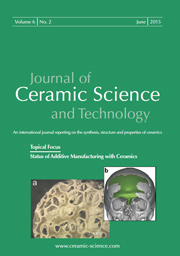Articles
All articles | Recent articles
Thermal Shock Resistance of ZrB2-MoSi2-SiC High-Temperature Ceramics Prepared by Spark Plasma Sintering
Y. Zhang1,2, J. Li1, W. Liu1,2, L. Zhang1,2, P. Zhu1,2, X. Yi1,2, S. Wei2, G. Zhang1, L. Jie2, K. Pan2, J. Shen3
1 Material Science & Engineering School, Henan University of Science & Technology, Luoyang 471023, China
2 Henan Key Laboratory of High-Temperature Structure and Functional Materials, Luoyang 471003, China
3 Department of Computer & Information Science, Michigan University, Dearborn, Dearborn, 48128, US
received May 3, 2020, received in revised form November 24, 2020, accepted November 29, 2020
Vol. 12, No. 1, Pages 49-58 DOI: 10.4416/JCST2020-00015
Abstract
In this study, ZrB2-MoSi2-based ceramics, namelyZrB2-15MoSi2, were produced by means ofspark plasma sintering technology. The effect of the amount of SiC additive on the microstructure of the oxide phase, morphology of the oxidized surface, thermophysical parameters, and thermal shock resistance were investigated with a variety of techniques, such as X-ray diffraction (XRD), scanning electron microscopy (SEM) with energy dispersive analysis (EDS), nanoindentation, and thermal expansion coefficient and laser thermal conductivity determinations. The measured thermophysical parameters indicate that SiC improves relative density and thermal conductivity, decreases the thermal expansion coefficient and elastic modulus, which is beneficial for thermal shock resistance. The investigation of the surface microstructure and cross-section of the sample after the thermal shock experiment indicates that although defects like gas pores and microcracks may be generated after the first thermal shock test, the material can self-repair with sufficient and melt-flowing SiO2 phase in the subsequent thermal shock tests. The oxide layer consists of SiO2-rich and SiC-depleted layers, and the thickness of the oxide layer depends on the SiC content. The addition of SiC improves the formation of the SiO2 oxide layer, prevents further oxygen penetration, and thus, reduces the thickness of the oxide layer.
![]() Download Full Article (PDF)
Download Full Article (PDF)
Keywords
Keywords: ZrB2-MoSi2-SiC ceramics, SiC additive, thermophysical parameters, thermal shock resistance, oxide layers
References
1 Jayaseelan, D.D., Wang, Y., Hilmas, G.E., Fahrenholtz, W., Brown, P., Lee, W.E.: TEM investigation of hot pressed-10 vol% SiC-ZrB2 composite, Adv. Appl. Ceram., 110, [1], 1 – 7, (2011).
2 Guo, S.Q.: Densification of ZrB2-based composites and their mechanical and physical properties: a review, J. Eur. Ceram. Soc., 29, [6], 995 – 1011, (2009).
3 Sun, Y., Xiao, X., Chai, G., Xu, G., Xiong, B., Zhang, S.: Microstructure, optical properties and thermal stability of ZrB2 and Zr-B-N thin films as high-temperature solar selective absorbers, Mater. Express, 4, [3], 205 – 212, (2014).
4 Chamberlain, A.L., Fahrenholtz, W.G., Hilmas, G.E.: Pressureless sintering of zirconium diboride, J. Am. Ceram. Soc., 89, [2], 450 – 456, (2006).
5 Akgun, B., Çamurlu, H.E., Topkaya, Y., Sevinç, N.: Mechanochemical and volume combustion synthesis of ZrB2, Int.J.Refract.Met.Hard Mater., 29, [5], 601 – 607, (2011).
6 Zhang, Y., Hu, Z., Yang, B., Ren, J., Li, H.: Effect of pre-oxidation on the ablation resistance of ZrB2-SiC coating for SiC-coated carbon/carbon composites, Ceram. Int., 41, [2], 2582 – 2589, (2015).
7 Wang, L., Liang, J., Wan, X.: Mechanical properties and thermal shock resistance of anisotropic ZrB2-SiC-graphite ceramic, Ceram. T., 248, 529 – 534, (2014).
8 Silvestroni, L., Meriggi, G., Sciti, D.: Oxidation behavior of ZrB2 composites doped with various transition metal silicides, Corros. Sci., 83, 281 – 291, (2014).
9 Silvestroni, L., Landi, E., Bejtka, K., Chiodoni, A., Sciti, D.: Oxidation behavior and kinetics of ZrB2 containing SiC chopped fibers, J. Eur. Ceram. Soc., 35, [16], 4377 – 4387, (2015).
10 Sarin, P., Driemeyer, P.E., Haggerty, R.P., Kim, D.K., Bell, J.L., Apostolov, Z.D., Kriven, W.M.: In situ studies of oxidation of ZrB2 and ZrB2-SiC composites at high temperatures, J. Eur. Ceram. Soc., 30, [11], 2375 – 2386, (2010).
11 Pourasad, J., Ehsani, N., Valefi, Z.: Oxidation resistance of a SiC-ZrB2 coating prepared by a novel pack cementation on SiC-coated graphite, J. Mater. Sci., 52, [3], 1639 – 1646, (2017).
12 Zhang, X., Xu, L., Du, S., Han, J., Hu, P., Han, W.: Fabrication and mechanical properties of ZrB2-SiCw ceramic matrix composite, Mater. Lett., 62, [6 – 7], 1058 – 1060, (2008).
13 Guo, S.Q., Mizuguchi, T., Aoyagi, T., Kimura, T., Kagawa, Y.: Quantitative electron microprobe characterizations of oxidized ZrB2 containing MoSi2 additives, Oxid. Met., 72, [5 – 6], 335, (2009).
14 Iatsyuk, I.V., Potanin, A.Y., Rupasov, S.I., Levashov, E.A.: Kinetics and high-temperature oxidation mechanism of ceramic materials in the ZrB2-SiC-MoSi2 system, Russ. J. Non-Ferr. Met., 59, [1], 76 – 81, (2018).
15 Paul, T.R., Mondal, M.K., Mallik, M.: Microstructure dependent physical and mechanical properties of spark plasma sintered ZrB2-MoSi2-SiCw composites, Int. J. Refract. Met. Hard Mater., 79, 131 – 137, (2019).
16 Sciti, D., Guicciardi, S., Bellosi, A., Pezzotti, G.: Properties of a pressureless-sintered ZrB2-MoSi2 ceramic composite, J. Am. Ceram. Soc., 89, [7], 2320 – 2322, (2006).
17 Wang, W., Sun, K., Liu, H.: Effects of different aluminum sources on morphologies and properties of ceramic floor tiles from red mud, Const. Build. Mater., 241, 118119. (2020).
18 Zhang, L., Wei, C., Li, S., Wen, G., Liu, Y., Wang, P.: Mechanical and thermal shock properties of laminated ZrB2-SiC/SiCw ceramics, Ceram. Int., 45, [5], 6503 – 6508, (2019).
19 Li, W., Zhang, X., Hong, C., Han, W., Han, J.: Microstructure and mechanical properties of zirconia-toughened ZrB2-MoSi2 composites prepared by hot-pressing, Scr. Mater., 60, [2], 100 – 103, (2009).
20 Fahrenholtz, W.G., Hilmas, G.E., Talmy, I.G., Zaykoski, J.A.: Refractory diborides of zirconium and hafnium, J. Am. Ceram. Soc., 90, [5], 1347 – 1364, (2007).
21 Monteverde, F.: The addition of SiC particles into a MoSi2-doped ZrB2 matrix: effects on densification, microstructure and thermo-physical properties, Mater. Chem. Phys., 113, [2 – 3], 626 – 633, (2009).
22 Silvestroni, L., Sciti, D., Kling, J., Lauterbach, S., Kleebe, H.J.: Sintering mechanisms of zirconium and hafnium carbides doped with MoSi2, J. Am. Ceram. Soc., 92, [7], 1574 – 1579, (2009).
23 Mallik, M., Kailath, A.J., Ray, K.K., Mitra, R.: Electrical and thermophysical properties of ZrB2 and HfB2 based composites, J. Eur. Ceram. Soc., 32, [10], 2545 – 2555, (2012).
24 Zimmermann, J.W., Hilmas, G.E., Fahrenholtz, W.G., Dinwiddie, R.B., Porter, W.D., Wang, H.: Thermophysical properties of ZrB2 and ZrB2-SiC ceramics, J. Am. Ceram. Soc., 91, [5], 1405 – 1411, (2008).
25 Hasselman, D.P.H., Donaldson, K.Y., Anderson, E.M., Johnson, T.A.: Effect of thermal history on the thermal diffusivity and thermal expansion of an alumina-aluminum titanate composite, J. Am. Ceram. Soc., 76, [9], 2180 – 2184, (2005).
26 Guo, S., Mizuguchi, T., Ikegami, M., Kagawa, Y.: Oxidation behavior of ZrB2-MoSi2-SiC composites in air at 1500 °C, Ceram. Int., 37, [2], 585 – 591, (2011).
Copyright
Göller Verlag GmbH


